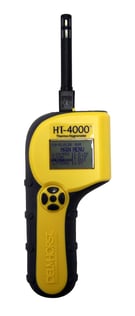ASTM International is an organization that defines and sets various standards for ensuring quality and safety for different products and services. Globally, the organization has released over 12,000 standards.
ASTM F-2170 is the standard for testing relative humidity in concrete floor slabs used by contractors all over the U.S.
But, why is this standard so important to any contractor dealing with concrete? Below are a few things that you should know about ASTM F-2170, but first and foremost, the ASTM FO6 Committee has recently voted and approved on a reduction in the wait requirement from 72 hours to 24 hours on the F-2170 standard.
1) It is the BEST Way to Monitor Moisture in Concrete Flooring
When there is excessive moisture in a concrete slab, it can have a negative impact on any flooring systems installed over the slab. However, it’s virtually impossible to achieve a precise moisture content measurement in concrete because of the physical differences between different concrete samples.
These differences can impact the concrete’s electrical conductivity and specific gravity from one sample to the next—even when the mix for the two samples come from the same manufacturer. This lack of consistency throws off moisture content measurements because moisture meters need to be calibrated for a specific set of physical characteristics to ensure accuracy.
The ASTM F-2170 testing method circumvents this problem by gauging the relative humidity (RH) conditions deep in a concrete slab instead of trying to directly gauge the water-to-solid mass ratio.
This allows for a more consistent measurement of how much moisture is likely to escape from the slab than trying to measure the %MC with a moisture meter would—which is the information that is actually useful for determining whether or not the slab is ready to be built over.
2) ASTM F-2170 Requires Thermo-Hygrometers with In-Situ Probes
To measure the RH conditions deep in a slab of concrete, it is necessary to have a thermo-hygrometer with an in-situ probe. The hygrometer is used to calculate RH, while the probe is there to be inserted into a hole users have prepared in the concrete so the meter can take RH measurements.
3) The Preparation Process for ASTM F-2170
The process for preparing a concrete for testing under the ASTM F-2170 standard takes several days to complete.
First, drill a hole that is 5/8” in diameter to a depth equal to 40% of the slab’s thickness. So, if your concrete slab is 12” thick, then the hole should be 4.8” deep.
A rotary hammer drill with a drill bit that has 3 or 4 cutting edges is recommended to ensure a smooth, round hole that will conform to the sleeve.
Second, vacuum the hole thoroughly. Then, use a wire brush to clean out or loosen any concrete chips remaining in the hole. Vacuum again to clear out the remaining concrete.
Third, insert a specialized sleeve into the hole and seal it with silicone or another water-resistant sealant. A rubber mallet can be used to force the sleeve into the hole and make sure it is sealed into the concrete. The cap for the sleeve should then be put in place, or the in-situ probe can be installed now.
Finally, after the cap is applied (or the in-situ probe is installed) the hole should be left to acclimate for no less than 24 hours. This is a change from the previous waiting time requirement of 72 hours. Once this acclimation is complete, you can either remove the sleeve cap and insert the in-situ probe to take a reading, or just take a reading with an already-installed probe.
4) The Number of Holes You Need to Prepare
The ASTM F-2170 standard calls for users to make at least three holes in the first 1,000 sq. ft. of concrete they’re testing, and one more hole per 1,000 additional sq. ft. of concrete slab.
So, if you had a slab of concrete covering 2,000 sq. ft., you would need to prepare at least 4 holes in the concrete.
5) Protecting Your In-Situ Probes
While leaving the in-situ probes in the concrete can be convenient for making later checks quickly, it can potentially damage a probe’s sensor element if there is too much moisture in the concrete. To minimize this risk, many professionals prefer to wait until the concrete holes and sleeves have already acclimated before inserting a probe and taking a reading.
Also, as per the standard, if you leave a probe in concrete for more than 30 days, it has to have its calibration checked before you can consider its readings valid in further tests.
6) The Best Thermo-Hygrometer to Use for This Standard
 To make sure that you’re getting accurate measurements of the RH conditions in concrete, you need to have an accurate and reliable thermo-hygrometer. The best thermo-hygrometer for this task will need to do several things, including:
To make sure that you’re getting accurate measurements of the RH conditions in concrete, you need to have an accurate and reliable thermo-hygrometer. The best thermo-hygrometer for this task will need to do several things, including:
- Be compatible with external probes.
- Acclimate to conditions quickly to get a fast reading.
- Adjust for temperature conditions so as not to skew RH measurements.
- Be calibrated to a traceable standard to ensure accuracy.
High-quality, external sensor-compatible hygrometers such as Delmhorst’s 4000F are indispensable tools for any contractor who is working with new concrete on the job.
Learn more about using thermo-hygrometers on the job by contacting us today, or by checking out the Complete Guide to Measuring Moisture in Restoration.

Comments